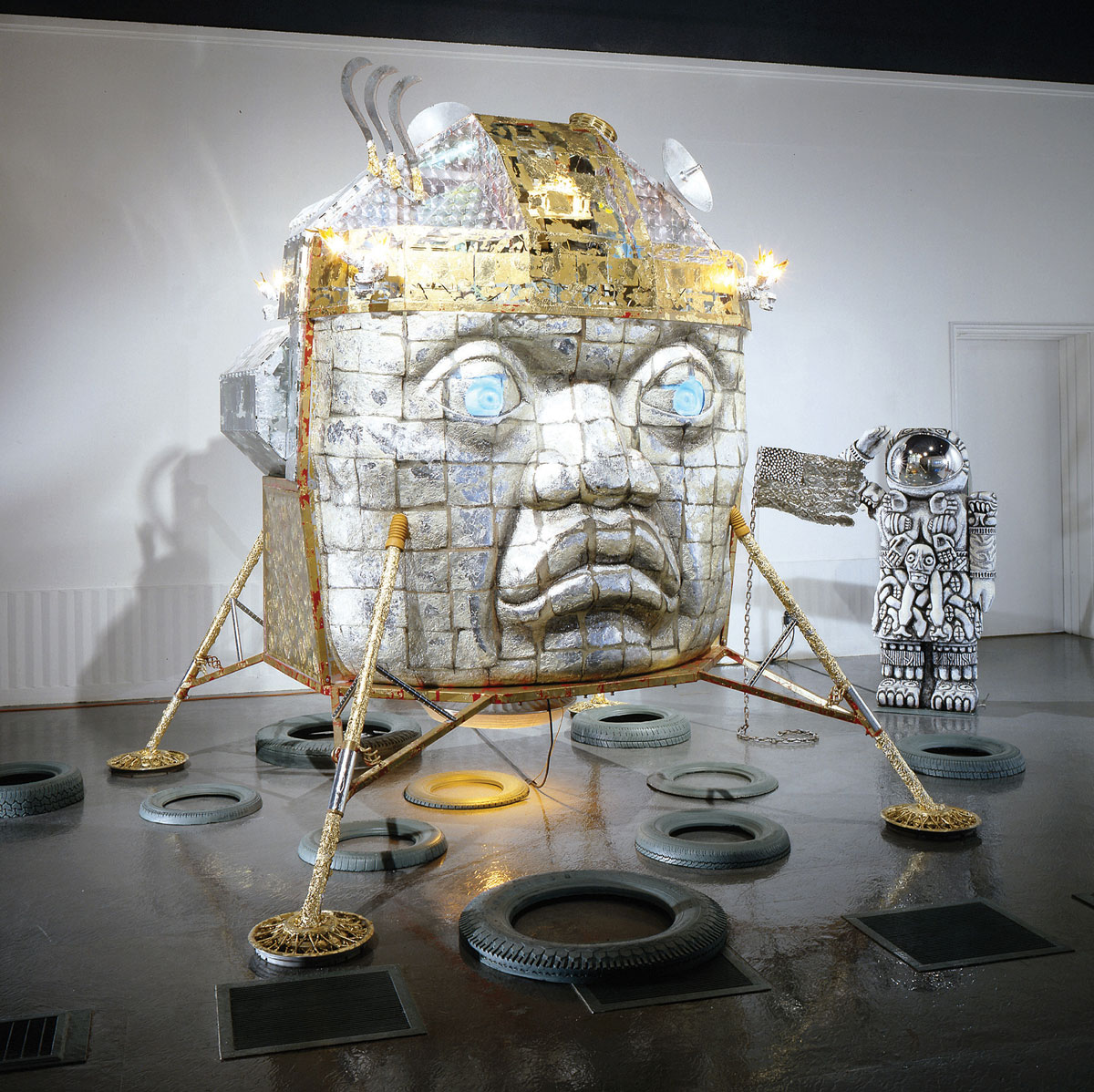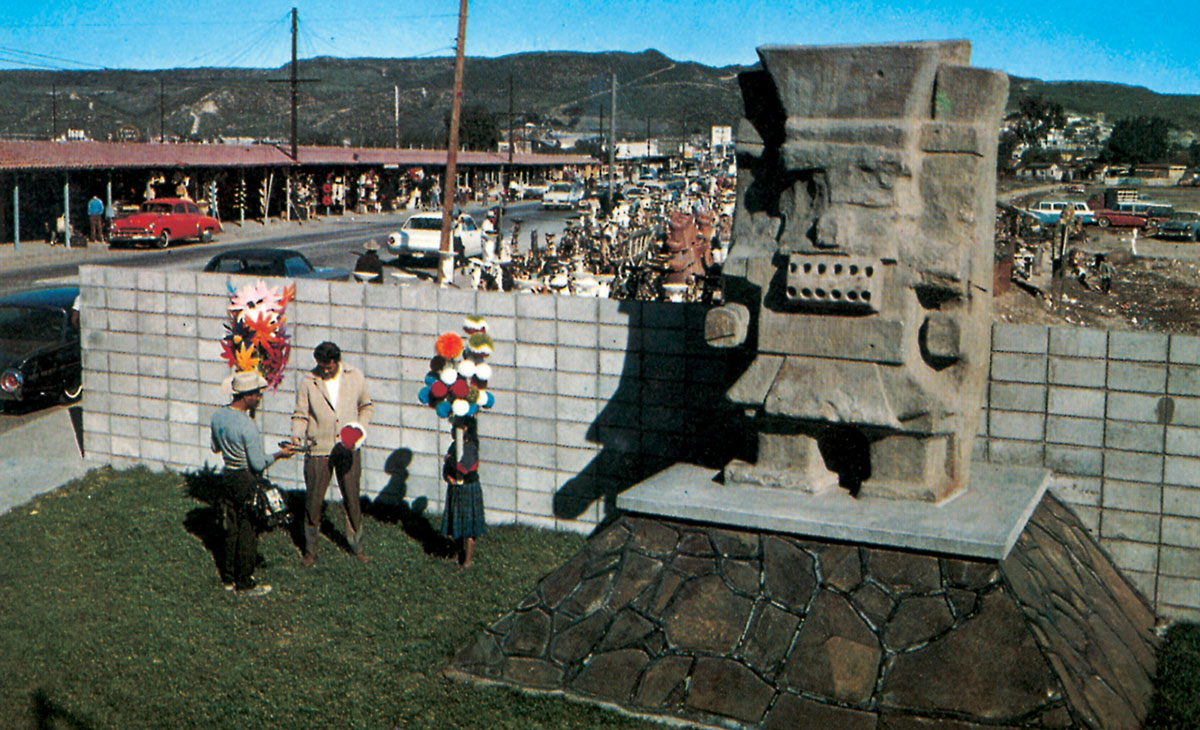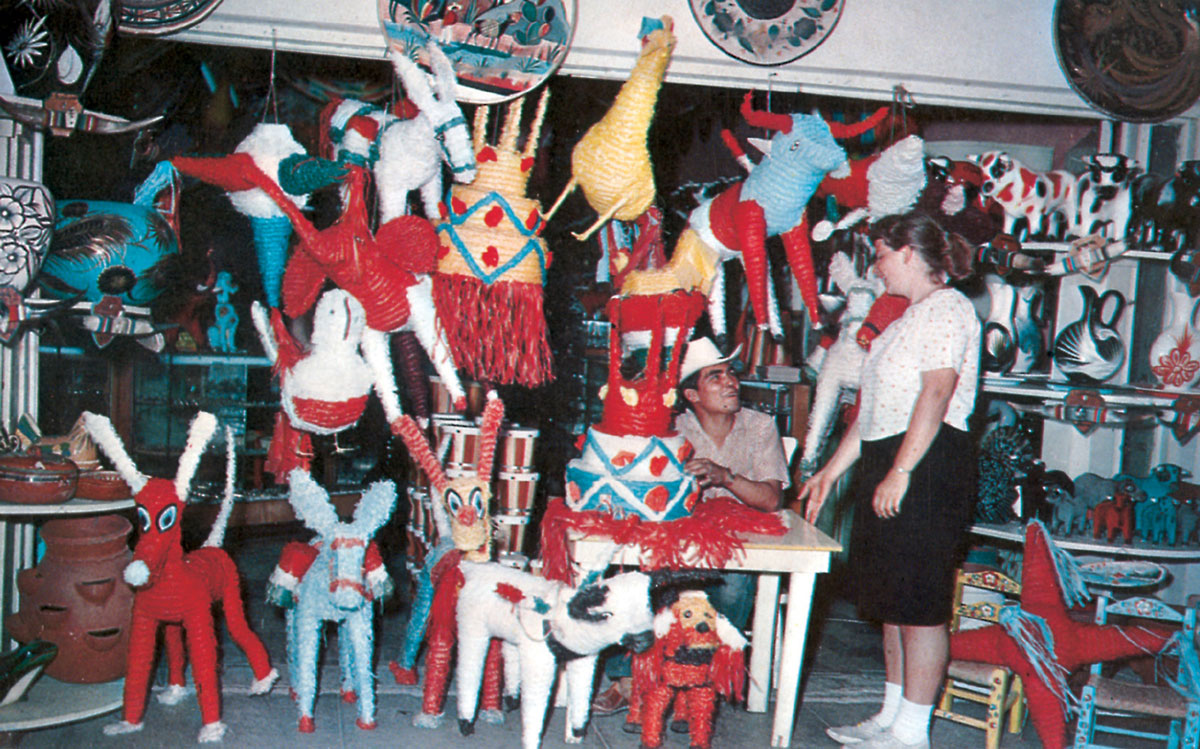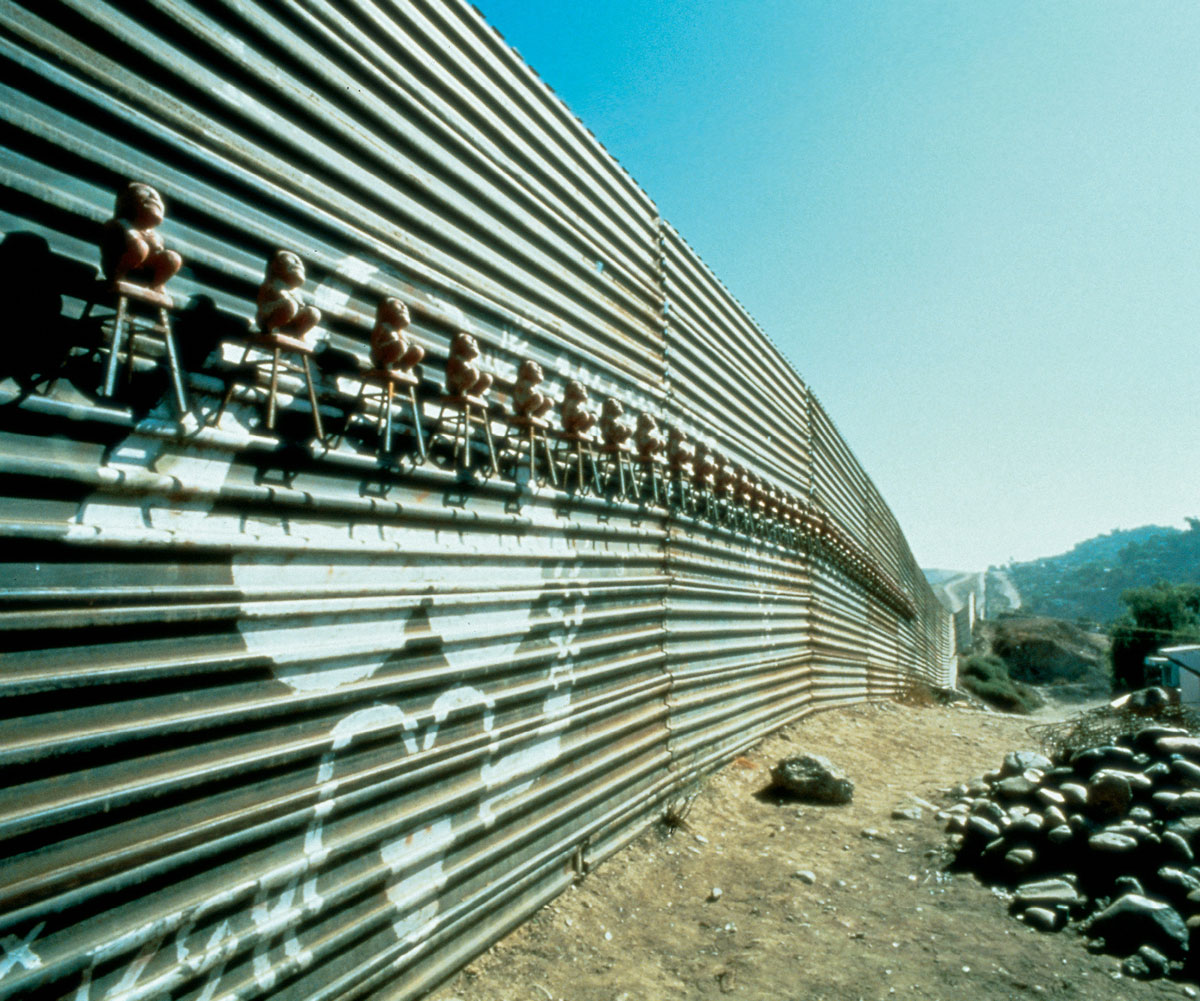Borderline Archeology
Janus-faced geography
Jesse Lerner

Surrounded by emptied quart bottles of Tecate beer and a pair of television monitors showing giant, shifty eyeballs, the renowned 7th-century ruler Lord Pacal, Maya noble of the ancient city of Palenque, has taken the form of a blond child bedecked in green feather boas and crossed the US-Mexico border in his pre-Columbian lunar module. Alongside his Olmec moon unit, a colossal head perched on gold-trimmed low-rider landing gear, the fearsome Aztec goddess Coatlicue dons her space suit and, like Neil Armstrong, salutes the US flag. One highly inebriated eagle has landed. This hallucinatory scene is a vision of Chicano science fiction, a futuristic fantasy of a post-NAFTA North American space program, and part of a mixed media installation by the brothers Einar and Jamex de la Torre. The pair moved from conservative, hyper-Catholic Guadalajara to beachside Orange County while still in elementary school. They grew up there in the 1970s, surfing, getting stoned, watching pseudo-archeological documentaries like In Search of Ancient Astronauts, and reading speculative accounts of pre-Conquest space travel, such as the immensely popular Chariots of the Gods by Erich von Däniken. Today they divide their time between San Diego and Ensenada. Their over-the-top installation introduces us to the strange transformations that occur when Mexico’s ancient cultural heritage reaches that country’s northern border, in this case, that most delirious zone at the border’s western extreme.[1] This region, where San Diego’s military bases and million-dollar ocean-view homes rub against Tijuana’s post-apocalyptic landscape wasted by neo-liberalism, is a space where the hybrid and the syncretic are the norm, and where mutations, no doubt induced by the tons of toxins dumped by the area’s many maquiladoras, proliferate madly.[2]
Prior to Spanish colonization, what is today the northwestern Mexican state of Baja California Norte was inhabited by Tipai, Paipai, Kiliwa, and Nakipa Indians. Their nomadic lifestyle and modest form of social organization are the reasons that the region lacks the spectacular pre-Columbian ruins that bring thousands of tourists to Mexico’s central valley and southern (Maya) region. The popular American mystery writer Erle Stanley Gardner pushed Baja’s murals as an attraction, but the tourists come looking for an essential, “deep” Mexico, and this means pyramids and colossal Mesoamerican sculptures. The petroglyphs and cave paintings that the region’s early inhabitants left behind in remote parts of Baja do not hold the same drawing power as do massive structures associated with stories about human sacrifices. As if to compensate for this perceived lack, we find constructions of a much more recent epoch: the numerous examples of displaced Totonac, Maya, Zapotec, and other ancient cultures rendered in plaster, fiberglass, or plastic, simulacra scattered throughout Baja’s largest city, Tijuana, and beyond. In their northward migration these objects undergo every kind of transformation, suggesting a virtual taxonomy of miniatures, replicas, and copies, all struggling collectively to assert the national mythology and history always in danger of receding.
Every such instance of the public display of pre-Columbian replicas in the border region is Janus-faced, simultaneously looking anxiously northward, to draw the free-spending tourists (while warding off the encroaching cultural menace they represent), and looking south to Mexico City, the gravitational center of national narratives. For the North American tourist, these objects function as signposts of alterity, highly visible markers of Mexico’s otherness, indicators that the traveler has left the US behind. They proclaim that Mexico is heir to a long and impressive cultural heritage, and that the “zonkey” (a Tijuana donkey painted with zebra stripes to pose for the characteristic tourist photo) and the all-the-tequila-you-can-drink special are not the sum total of Mexican culture. Certain examples, by virtue of their placement or their English language signage, seem to principally have this function. This is the primary function of the Olmec, Teotihuacán, and Maya replicas that line Tijuana’s Avenida Revolución, the most touristic thoroughfare offering at all hours plentiful alcohol in themed bars (Red Square, the inevitable Hard Rock Café), “Aztec massage” parlors, and gentlemen’s clubs catering to visitors.
For the Mexican, the archaeological replicas have an altogether different function. Their presence in the cityscape reconnects the center with Tijuana, a problematic place for nationalists at the furthest margin of the country, distant from the interior of the nation and its centralist myths and identity. Like ancient Rome and its empire, Mexico City and the rest of the republic exist in a highly asymmetrical relation of power, one that must be continuously reasserted and renegotiated. Residents of the capital fear that the border breeds a dangerous drift of identity, subject to the nearly irresistible pull of the larger northern neighbor. Residents of the border, they like to say, speak Spanglish (a bastardized Pocho slang or Caló) rather than proper Spanish, and too readily embrace other markers of a North American (US) identity. It is tempting to read these Chilango (Mexico City) criticisms as a reflection of their own anxieties about the erosion of national traits in an era of globalization. But in this context, statues like the monument of the last Aztec emperor Cuauhtemoc on the Paseo de los Heroes anchor Tijuana within national narratives. Even as these objects function as ties binding the Mexican republic’s most distant urban outpost to the center, they reveal those gaps that separate its precarious border realities from those of the interior.
The latter-day archeological objects in Tijuana derive from different practices and motivations, ranging from commercial impulses to commissioned, high-profile exercises in site-specific art installation. The most readily visible examples are simply money-making ventures, like thousands of plaster of Paris miniatures of the Aztec “calendar stone” airbrushed with neon and reflective metallic paints, the Chac Mool ashtrays, and all the rest of the kitsch tourist art that abounds. If it is true, as Josiah Wedgwood claimed, that copies of ancient objects “most effectively prevent the Return of Ignorant and barbarous Ages,”[3] then Tijuana is surely in the vanguard of this struggle against barbarism.
The art world produces multiples as well. Seated on a row of steel stepstools attached to the fence that demarcates the international boundary, 111 identical plaster figurines representing the Aztec goddess of filth and putrefaction, Tlazoltéotl, grimace in the pain of childbirth. These replicas form a site-specific art piece by the contemporary conceptual artist Silvia Gruner, as part of the international arts showcase InSITE ‘94. The setting for the installation was Tijuana’s working-class Colonia Libertad, a neighborhood that at the time was often used by undocumented immigrants as an embarkation point for the dangerous northward crossing.[4] Suspended in the act of giving birth, Tlazoltéotl is a liminal figure, forever between pregnancy and motherhood, installed within a liminal space, the threshold between the US and Mexico, between the First World and the Third, between North and South. For the migrants passing through the area, this dangerous crossing point marks the space between home and exile, citizenship and “alien” status.
The original jade upon which Gruner’s figurine is modeled is itself a border-crosser. Purportedly from Central Mexico (though the American Museum of Natural History’s Gordon Ekholm used to insist that it is a fake), an officer of the defeated Emperor Maximilian brought the object to Paris, where a description of it was first published.[5] Subsequently, diplomat and art collector Robert Woods Bliss acquired the sculpture, and it is currently exhibited as part of his collection at Harvard’s Dumbarton Oaks in Georgetown. Gruner’s reuse of the figurine as the prototype for multiple ceramic replicas perched on the fence in Tijuana completes a circuitous migration that corresponds to imperial claims on Latin America, first from the Old World, then from the Yankees. Multiplied over and over, the Tlazoltéotl figure returns to Mexico not as repatriated cultural heritage, but as a signpost for the border crosser, an incongruous aberration on the very visible marker of the international line that is the border fence.


Nowhere in Mexico is the nation’s architectural heritage miniaturized on a scale comparable to the failed theme park called Mexitlán, Ramírez Vázquez’s enormous roof-top celebration of Mexico’s architectural heritage located just a few blocks from the busiest international border crossing in the world. Of all the pre-Columbian figurines, replicas, degraded copies, and striking likenesses found in Tijuana, this is by far the most ambitious. In the spirit of the models at Surrey’s Thorne Park, the Netherlands’ Madurodam, the 1939 New York World’s Fair speculative miniatures of New York in the year 1960, Beijing’s “World Park,” and Shenzhen’s “Splendid China,” Mexitlán’s miniatures of the pyramids at Chichén Itzá, Teotihuacán, Tlatelolco, and of the Great Temple of pre-Conquest Tenochtitlán are all rendered skillfully and meticulously. Tijuana and the rest of the border region, lacking any architecture that (by the criteria operating here) rate as significant, is not represented, though just beyond the perimeter of the park the oversized signage for a Smart and Final store insistently reminds the visitor of border realities. The nation is reduced to a scale at which its entirety can be surveyed in a glance. Not one to be guilty of false modesty, Ramírez Vázquez includes one of his own buildings, the National Anthropology Museum from Mexico City, among the scaled-down survey of the nation’s architectural highlights. Though unquestionably impressive on an aesthetic level, Mexitlán has not been successful economically. It is not hard to imagine why this might be, as it is at once not fun enough to be an amusement park, too expensive for most Tijuana residents, not meaningful to most tourists (who don’t know the original buildings referenced), and not educational enough to be a museum. After the initial public response proved disappointing, the owners removed some of the models and began to book local punk bands on weekends. They found they had to install temporary fences to prevent slam dancers from stage-diving on to the miniature National Palace of Fine Arts or pogoing onto the diminutive Temple of the Inscriptions from Palenque. Even this desperate effort to bring in crowds was not enough to make Mexitlán financially viable. Today, the park is closed, the architectural models stored unceremoniously on their sides in the structure’s parking garage. Only the weather-worn sign, a giant, decaying plastic piñata, and the nearly life-size replica of the Atlante of Tula on the sidewalk by the front entrance now mark the spot of this once-fabulous exercise in replication.

A few blocks away, in a tourist development called the Pueblo Amigo, another replica of Palenque, this one closer to the scale of the original, has recently been completed. The architects responsible have clearly learned as much from Las Vegas as they have from the Maya. Synthetic materials cover the structure to approximate the appearance of hewn stone. Feathered serpents copied from Teotihuacán (enhanced with water spouts emerging from their mouths), a bamboo banister straight out of a Tiki bar, a waterfall cascading down the building’s façade, and the inexplicable stand of papyrus reveal an eclectic sensibility reminiscent of the Mexican structure at Epcot Center. This past summer, the building opened as a neo-Maya borderland discotheque. The presence of both Mexitlán’s miniature Palenque ruins and the disco Palenque in such proximity redoubles Tijuana’s search in the ruins. Nashville, Tennessee, has only one Parthenon, after all, and Slobozia, Rumania, has only one Eiffel Tower (and one replica of the Southfork Ranch, as featured on TV’s Dallas). Tijuana, a place where less is never more, could not settle for one. The disco Palenque is streamlined and altered to accommodate its new function, and is principally identifiable as Palenque because of the multistoried tower, unique in Mesoamerica. Mexitlán’s miniature Palenque is more complete, and includes not only the palace with its tower but also a scale model of the Temple of the Inscriptions, where the mortal remains of Lord Pacal—and the relief carvings that inspired the de la Torre brothers—were found. In that temple, in distant Chiapas, in the far south of Mexico, the Mexican archeologist Alberto Ruz discovered in 1952 that the stone slabs of the floor concealed a staircase leading down into the structure’s interior and descending to a large, corbelled chamber containing the king’s sarcophagus. The lid depicts the ruler in an ecstatic state, curled up and reclining backwards. Archeologists understand the relief as representing the king’s rapturous entry into the underworld upon his death, but more fanciful viewers have interpreted this as proof of pre-Columbian space travel, noting the similarity with the characteristic position assumed by astronauts in flight. Crash landing over the delirious landscape of Tijuana like the exploding Columbia shuttle, scattering chunks of detritus hither and yon, these ersatz pre-Columbian artifacts are true mutant landmarks within a heady border geography.
- The installation was created for “Mixed Feelings,” an exhibition at the University of Southern California’s Fisher Gallery about the border metropolis.
- Maquiladoras are factories run by multinationals just inside Mexico’s border with the US.
- Quoted in David Lowenthal, The Past is a Foreign Country (Cambridge: Cambridge University Press, 1985), p. 306.
- Subsequently, the reinforcement of the border fence, part of a continuing militarization of the international border, has forced this illicit migration further eastward.
- E. T. Hamy, “Note sur une statuette méxicaine,” in Journal de la Société des Américanistes, vol. 3, no. 1 (1906), pp. 1–5.
Jesse Lerner is a documentary filmmaker based in Los Angeles. His book F is for Phony: Fake Documentaries Undoing History, Identity and Truth (with Alexandra Juhasz) is forthcoming.
Spotted an error? Email us at corrections at cabinetmagazine dot org.
If you’ve enjoyed the free articles that we offer on our site, please consider subscribing to our nonprofit magazine. You get twelve online issues and unlimited access to all our archives.